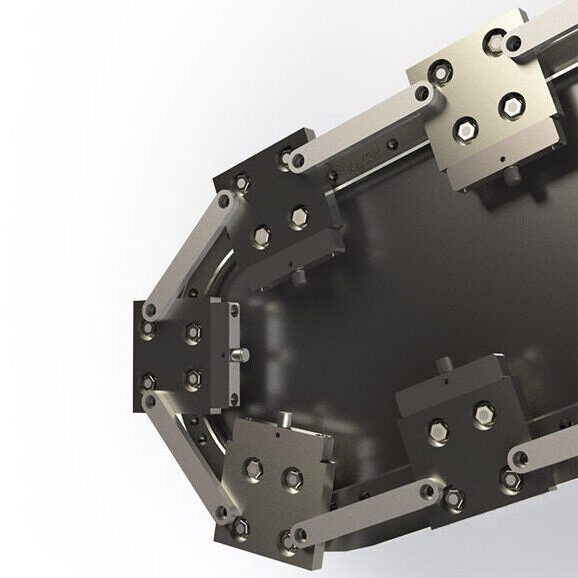In the rubber and tyre manufacturing process, the rubber block from the refiner needs to be transferred to the calendering or vulcanising equipment through the conveyor line, and the high temperature rubber block (above 60℃) is very easy to stick to the inner wall of the hopper. The traditional hopper due to the turning angle is not enough (usually <45 °), the residual rubber blocks need to be cleaned manually, resulting in frequent downtime, efficiency plummeted 20% or more. This article will be in-depth analysis60-90° large angle turning hopperThe innovative design of how to cure the stubborn problem of adhesion.
Why do glue blocks stubbornly stick? What are the limitations of traditional designs?
Temperature and physical properties are the main causes of adhesionAfter refining, the temperature of the rubber block is as high as 60-90℃, the activity of the rubber molecular chain is enhanced, and it is easy to form physical adsorption and chemical adhesion when it comes into contact with the metal hopper. If the surface finish of the hopper is not enough or there are microporous, the adhesion is further aggravated.
The lack of flip angle is a fatal flawTraditional hopper is limited by the upper end of the guide rail arc bending structure, the flip angle is usually limited to 45 ° or less. Due to the lack of gravity, the lumps can not be completely detached, and the residual rate can reach 15%-30%. manual cleaning requires 3-5 stops per shift, and the annual loss of man-hours is more than 500 hours.
Rigid structure increases wear: Hard collisions between the hopper and the guideway (as shown in the motion trajectory in Fig. 4) lead to deformation of the contact surface, an increase in the surface roughness, and the formation of more adhesion points.
How to achieve 60-90° residue-free flipping? Core design breakthrough point
1. Separate drive structure of spindle-lift bracket
-Principles of Subversive Movement: The spindle (42) is fixed transversely to the bottom of the hopper (4) and driven along the lifting support (2) by the traction mechanism (3). The overturning angle is no longer limited by the arc radius of the upper end of the guide rail (1), but depends on theDifference in height between the spindle and the upper end of the guideway(ΔH), the angle controllable range is extended to 60°-90°.
-Dual bearing redundant design: The swivel shaft (42) is mounted in both bearing housing two (41) of the hopper and bearing housing one (30) of the haulage mechanism. In the event of failure of either bearing, the other bearing can still maintain the turning function, reducing the failure rate by 40%.
2. Intelligent travel switch to accurately locate the flip point
A travel switch (5) is provided at the upper and lower ends of the lifting bracket (2) when the switch is triggered by the protruding end (420) of the rotating shaft end:
-Limit switch: Control the hopper to start tipping at the optimum position (ΔH ≥ 1.2 times the height of the hopper) above the upper end of the guide rail, ensuring a tilt angle of ≥ 60°;
-lower limit switch: Avoids hitting the mixing chamber (1000) when the hopper is falling back and protects the equipment interface.
3. Hopper-guide dynamic fit anti-impact
-wide front and narrow back structureThe width of the front end of the hopper is more than the distance between the guide rails and less than the distance between the lifting brackets. When turning over, the front end is connected to the bent section of the guide rail to avoid over-turning; when falling back, the rear roller (43) contacts the guide rail first to achieve a flexible transition.
-Roller Double Point Layout: The front and rear ends are equipped with rollers (43), the whole rolling friction instead of sliding, the guide rail wear is reduced by 70%.
How can the effect be multiplied when combined with assisted anti-stick technology?
1. Upgrading of the inner bucket material (UHMWPE)
Inside the metal bucket (1) with ultra-high polymer polyethylene anti-slip bucket (2), the surface friction coefficient is only 0.07-0.11, the glue block sliding resistance decreased by 50%. vibration motor (5) work through the bottom of the spring (3) to transfer the high-frequency micro-vibration, and further peeling off the residual glue block.
2. Temperature control module to suppress adhesion (optional)
-Heating tubes (5): Increase the temperature to 80°C during gluing to reduce the viscosity of the glue block;
-Cooling tubes (6): Cool down quickly to below 40°C after cleaning to avoid pre-adhesion of the next batch of glue blocks.
Measurements have shown that with temperature control the residual rate can be reduced to below 0.5%.
3. Physical isolation of anti-sticky chains (heavy load scenarios)
Fix the anti-adhesive chain (1212/1222) at the back of the hopper, the distance between the chains is ≤5mm, the glue block falling by the chain elasticity collision, destroying the adhesion layer, especially suitable for high humidity glue.
Implementation case: a tyre factory dense refining - calendering line transformation effect
| norm | pre-conversion | After modification (90° turning hopper + anti-sticking hopper) | Enhancement |
|---|---|---|---|
| Residual glue block quantity | 8-12kg | ≤0.3kg | 98%↓ |
| Average number of daily shutdowns | 4 times | 0th | 100%↓ |
| Hopper replacement cycle | 6 months | 24 months | 300%↑ |
Summary of design points: The 60-90° turn is central to the eradication of adhesions and needs to be done byShaft separation drive + stroke control + flexible contactRealisation; supplemented byMaterial modification (ultra-high polymer polyethylene)maybeTemperature control moduleCan cope with extreme working conditions.anti-sticky chainOn the other hand, it is a cost-effective solution for high-moisture gels.
Through three-dimensional collaborative design (mechanical structure + material science + intelligent control), the adhesion problem of the glue block conveying line can be systematically overcome. The future direction is to integrate AI vision to monitor the hopper status in real time, dynamically adjust the turning angle and vibration frequency, and move towards the goal of "zero residue".













